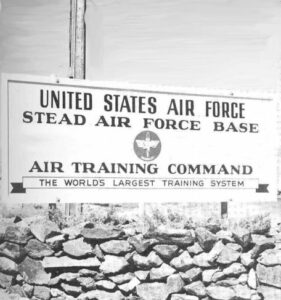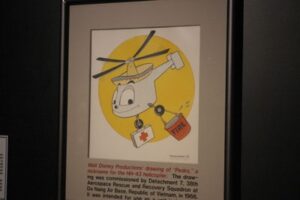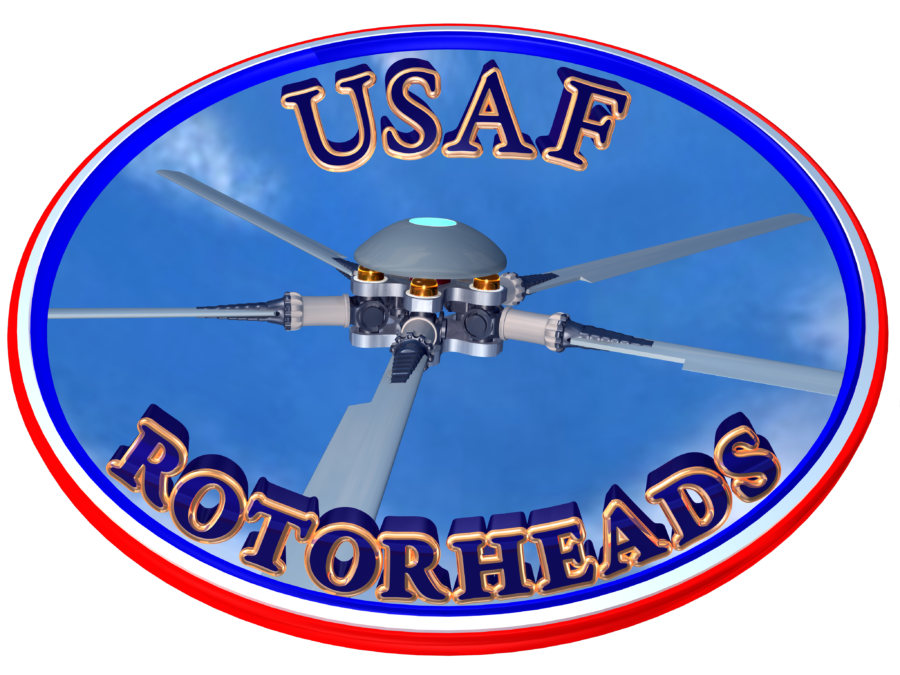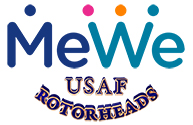Patches
Various patches were designed and authorized for wear by the many Air Force helicopter units. These patches instilled morale and created an esprit de corps within the unit and provided instant unit or organizational recognition.
There were also "unofficial" patches, that were worn by many unit members. These patches in some instances did not reflect the unit. As a result we have established two pages for patches, one for "Unit" and one for "Miscellaneous" Patches. The images have been provided by various members of the group and are displayed in no particular order.
If you have images of additional patches or information/comments on a particular patch please contact us.
HISTORY OF THE “USAF ROTORHEADS” LOGO/PATCH

Logo design by Bill Lyster

Patch
Early in January 2007 Jim Burns, Bill Crawford, Ron Smitham and Jim Moore began preliminary discussion concerning the idea of a Logo that would be representative of the “USAF ROTORHEADS’’.
Jim Moore drew up some basic ideas on how the Logo might look to be representative of the group. Jim Burns stated he would like to do something with Corel Draw and offered to proceed.
On 16 January 2007 Jim Burns took on the challenge to create several drafts of a “USAF ROTORHEADS” Logo. Utilizing input received from several members of the group, Jim put together several draft images of a Logo. With each draft new comments/suggestions were received and Jim took them and incorporated them into draft Logos.
Jim Burns felt that we needed to have a Logo that would be representative of all Air Force helicopters and not a specific type(s) or mission.
An oval and a round Logo became the two types of Logos the group members were most interested in. The oval Logo became the style of choice.
Bill Lyster seen what Jim Burns was working on and offered his assistance and suggested we make three-dimensional models, including the environment, and lights, using 3D software.
Bill Lyster then began making the models (rotor assembly - hinge pins, reservoirs, rotor blades, letters, etc...) working with feedback from the “Logo” committee consisting of Jim Burns, Bill Crawford, Bill Lyster and Jim Moore. Bill Lyster spent countless hours designing the models for the four Logos, creating the scenes rendered using several camera views, and many lighting variations, while making the images for the logo. These renders took up to 24 hours for each scene. He made a scene to satisfy each committee member, and gave committee members the option to modify their scene as he progressed, and then made a scene to his liking. This resulted in four unique logo renditions.
On 29 April 2007 the four Logo images were sent to the membership to vote on. On 6 May 2007 by a unanimous vote the membership selected the Logo that became the “USAF ROTORHEADS” Logo.
The selected Logo was then given to the embroidery shop to be utilized to make the official “USAF ROTORHEADS” patch. The embroidery shop sent the image off to be placed in a format compatible with the shop’s machines. Jim Burns worked closely with the embroidery shop reviewing several “draft” versions and tweaking them to insure the best possible product.
On 20 October 2007 the final product was received from the embroidery shop. Jim Burns designed a membership certificate, letter and along with a patch Jim mailed them to current “USAF ROTORHEADS” members during the first week of November 2007.
USAF ROTORHEADS thanks the members for their time and effort with design ideas and the selection process. Thanks to the Logo committee for their effort with a special thanks to Jim Burns, Bill Crawford, and Bill Lyster for their tireless efforts that resulted in a great patch, one the group can be proud of.
PATCH HISTORY
Patch origination and design usually was the result of someone's vision of what a unit patch should look like in order to represent the unit and give the unit recognition. Many patches originated from a basic drawing by individuals and evolved into a patch that often was officially approved for wear by unit members. Others were patches that signified some event or action and were not approved, however they were often worn, especially by units in SEA. In some instances the final patch was much different than the original design/vision.
This section is devoted to the history behind some of these patches.
304th ARS
The 304th had a unique but humorous patch. The patch evolved from various summer activities of the unit. Fellow Rotorhead Associate member Felix "Mac" McLarney provide this humorous story of the evolution of the 304th "Duck" patch.



Each summer camp a half day break with softball game or volleyball was scheduled to break the monotony. Usually the age old separation of officers and enlisted prevailed, and provided some bragging rights for the next year.
After a few years of this winner looser joshing one of the commanders purchased one of those little inexpensive (I should say cheap) trophies that could be found all over the place. This one featured a mule (jackass if you will) and was presented by the winning side to the losers during commander's call at the next training weekend after the summer camp. It usually was placed near the coffee bar in the HQ/Ops building.
A new commander came on board and he decided that instead of presenting the little trophy he would (and did) replace it with a very real and cantankerous jackass. The losers had to care and feed it which wasn't very funny after a short time. No one had any acreage or working farm to house it, or didn't offer such anyway, so it was placed in the fenced area that housed our personal equipment/parachute shop, and vehicle parking shed. Being alone was not what this animal wanted so each and every time someone had to go in or out of the fenced compound they had to deal with an agitated beast. Fortunately at this time there were no active duty folks residing on the base at night as they would have been up in arms with the constant braying throughout the night. It was a joke our CO felt was amusing, but we never really understood his personality. Shortly after he left the animal was given away and all was quiet.
But not to be outdone, the summer games continued and someone decided that a duck would be an appropriate trophy as well as a reminder to the losers who had to care for it. What happened next was not expected. Instead of the duck being a losers badge it became the mark of Zoro, or rather I should say its feet became the mark. As our crews visited other units and bases folks would wake up the next day to find duck feet images walking across their floors, at one base clinic they went up one wall, across the ceiling and down the other. At another they were placed next to the water coolers in a hangar. And to top it off, when AFRes built us a new ops admin building there were duck feet walking up to the building cast permanently in the new concrete sidewalk.
Hover over the images to see the descriptions
The duck lasted a good deal after I retired, and was eventually lost as a hawk was selected when the unit was placed under a Rescue Wing. No idea what did happen to the duck, but its loss as a logo is indicative of the lack of humor at Wing levels. So, while the University of Oregon has a duck for its team mascot, the 304th duck rose from a much more noble and distinguished background. You'll note its collar says Huey, which isn't necessarily creative but certainly appropriate.
The "Flying Snoopy"
The "Flying Snoopy" patch was worn by the H-19 Missile Site Support personnel at Forbes AFB, circa 1961. The image on the left is a copy of the original sketch that cartoonist Charles Schulz, of Peanuts fame, did for the patch. On the back it says, "Helicopter Operations, Forbes AFB, Kansas". USAF ROTORHEADS thanks Brett Foster for these images as well as the additional images we have on our patches page. Brett's father is James W. Foster who is a retired Air Force helicopter pilot.
AIR RESCUE SERVICE
Based on a study completed by Lieutenant General Hoyt S. Vandenberg after the end of hostilities in WWII, the Air Rescue Service(ARS) was stood up under Air Transport Command (ATC) on 13 March 1946 and based at Washington National Airport. In December of the year, Colonel Richard T. Kight took over command of ARS. Colonel Kight had been tasked to either build up ARS or shut it down.
His first reaction was to wash it out. But before he scrubbed Rescue out of existence he felt he had to make a survey not of paper but of people. He went on a tour of his units. What he saw and heard were a revelation.
He found physical conditions as bad as he thought they were. They had nothing, no decent airplanes to fly--there was not in existence one single airplane designed specifically for Rescue work. He also found out that despite all the issues, his Rescue kids owned a collective morale that was high and wide and screaming. He didn't understand it, they were ready to whip the world with nothing. It didn't make any sense until one day a young Lieutenant told him, "I'd rather save people than kill them." Kight understood and realized that he had found his own mission in the Air Force.
He became an avid supporter of the organization and implemented plans and programs that pushed for the improvement and expansion of the service and its rescue culture. He wrote the rescue code and motto, created its emblem, and fought hard for more resources. In 1947, Colonel Kight also initiated the formal founding of USAF pararescue based on heroic precedents in WWII and soon medical parachute jumpers were added to ARS. He held this command until 1952, directing its development and expansion and introducing present day rescue techniques. He personally performed much of the testing of rescue equipment and employment techniques.
~~~
CODE OF AN AIR RESCUE MAN
It is my duty as a member of the Air Rescue Service to save life and to aid the injured.
I will be prepared at all times to perform my assigned duties quickly and efficiently, placing these duties before personal desires and comforts.
These things I do that others may live.
~~~
He printed these lines on cards and distributed them throughout the Rescue Service for his men to read and carry with them.
He then designed an emblem that would symbolize Rescue: a blue sky streaked with a golden ray of hope and on it an angel with his hands around the world. And on the bottom of the insignia the last lines of the code: “That Others May Live.”
In April 1960, he was promoted to the rank of Brigadier General
Retired Sep. 1, 1967. Died June 17, 2001.
(ABOVE IN FORMATION GATHERED FROM THE INTERNET AND "RESCUE" BY ELLIOT ARNOLD)

When the TAC helicopter troops had to leave TAC and enter MAC. When we stood the 23rd AF up at Scott under MAC in 1983 some of them made up the patch. There was no love lost between TAC and MAC in those days. They even had a big MAC patch burning party down at Hurlburt but they eventually got over it.
The 23rd moved from Scott to Hurlburt in 86 and in the late 80's became the AFSOC. The AFSOC picked up all rescue helicopters until recently when combat SAR went back to ACC (the old TAC). Go figure. You can please some of the troops some of the time but you can't please all the troops all the time.
COURTESY OF JOHN FLOURNOY
 5040th HELICOPTER SQUADRON
5040th HELICOPTER SQUADRON
The Alaskan Air Command’s 5040th Helicopter Squadron was formed at Elmendorf AFB, Alaska in 1970. The new patch was designed by Captain Duane "Smoke" Daily. The design incorporated the blue sky at the top with the stars of the Big Dipper, which was part of the Alaska State flag. The round white "top of the world" showed our location in the far North with white snows of the glaciers. The yellow "swing" wings of the great flying bird represented the helicopter. In the bird's strong talons were the Lifesaving ring of rescue and the square box of supplies that we carried to the remote radar sites.
COURTESY OF K V HALL
USAF HELICOPTER SCHOOL
The USAF Helicopter school has been located in many locations since being established. The Black and White patch below was in the Air Training Command Manual 51-2, circa 1952, when the school was located at San Marcus TX. (The text and images below have been provided through the courtesy of K V Hall, John Flournoy and the USAFHPA).
When helicopters came on the scene in the early 1940's, they were a great novelty. To just imagine how they flew was mind boggling, thrashing about the sky and making lots of noise. Someone made the comment that they looked like a flying eggbeater. For a time they were referred to as "eggbeaters". Walt Disney studios created many designs for insignia during World War II and apparently someone asked them to come up with a cartoon type design to represent the helicopter. Thence emerged the concept of the "flying eggbeater" piloted by a Disney gremlin. The design floated around for awhile and in the 1950's began to show up frequently in the USAF Helicopter School. A patch was made up and unofficially adopted as the School Patch. Former instructor pilots, mostly retired, that at one time were assigned to the USAF Helicopter School were the founders of USAFHPA. The "Flying Eggbeater" was adopted as their official logo.
When the Helicopter School moved to Stead AFB NV the two patches above evolved from the original design. There are some that think there may have been a patch where the "eggbeater" was headed in the opposite direction. This well could have been the result of the image being turned over when the badge was made.
The USAF ROTORHEADS are very appreciative of the USAFHPA providing us with these images and words.
It is all a part of Air Force helicopter history and we are honored to be associated with such a fine organization.


This Walt Disney Productions drawing of "Pedro" was commissioned by Detachment 7, 38th Aerospace Rescue and Recovery Squadron (ARRS), Da Nang Air Base, South Vietnam in 1966. The insignia design was inspired by the unit's radio call sign of "Pedro". Planned as the unit insignia for all H-43 helicopter units in Southeast Asia, the pace of the war prevented it from being implemented. This drawing, however, meant a great deal to those who flew PEDROs at Da Nang, and elsewhere

This party suit belonged to Col. Don Jensen, who was the 38th ARRS commander from Feb 1970-Feb 1971. Illustrating how the design became part of the unit culture, the embroidered design shows "Papa Pedro," a variation on the PEDRO theme utilized by the 38th ARRS.
(IMAGES AND TEXT LOCATED ON THE INTERNET)
Integrity, Honor, and Respect
Some of the best things cannot be bought, they must be earned
©2023 USAF Rotorheads All Rights Reserved | Financial Statement












